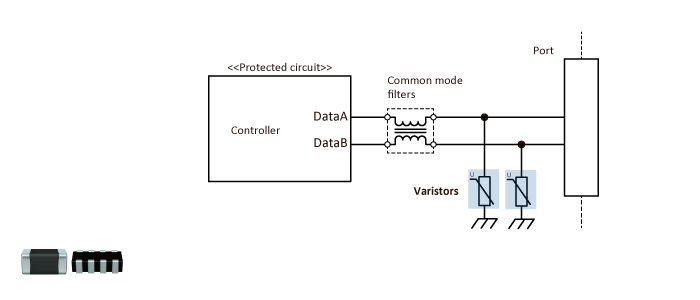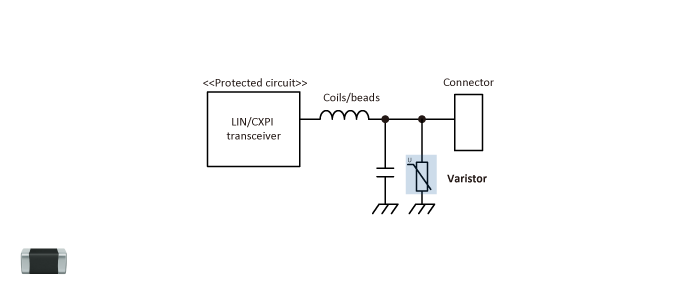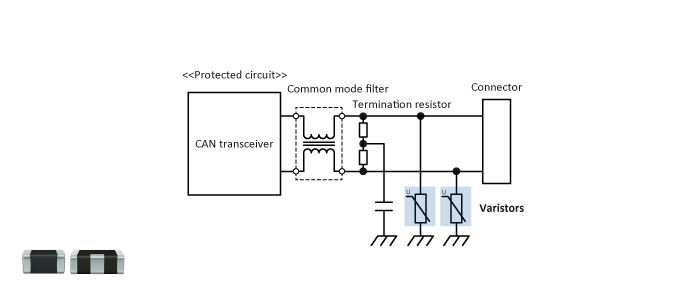SMD or chip varistors are voltage-dependent resistors based on ceramic multilayer technology. They are widely used to protect electronic circuits in consumer devices and telecom, industrial and automotive applications against transient overvoltages, such as electrostatic discharges (ESD) and surge transients.
About multilayer SMD varistors
SMD varistors are overvoltage protection devices that utilize the properties of semiconductive ceramics. When the voltage across the varistor exceeds a certain value, the resistance falls to a low value and allows a current to flow, thus providing overvoltage protection to the electronic devices that are connected in parallel with the varistor.
Below are some examples of effective ESD and surge protection using SMD varistors.
Table of Contents
- Sample application: ESD/surge protection for I/O units such as switches, keys, buttons, connecting terminals, etc.
- Sample application: ESD/surge protection for audio (voice) lines
- Sample application: ESD/surge protection for I/O interfaces [RS-232C/RS-423]
- Sample application: ESD/surge protection for I/O interfaces [RS-422/RS-485]
- Sample application: ESD/surge protection for I/O interfaces [USB 2.0 / USB SS]
- Sample application: ESD/surge protection for I/O interfaces [HDMI/LVDS]
- Sample application: Surge/noise suppression for automotive LAN interfaces [LIN/CXPI, CAN/CAN-FD]
- Sample application: Surge/noise suppression for automotive LAN interfaces [MOST50]
- Sample application: Surge/noise suppression for automotive LAN interfaces [In-vehicle Ethernet (100Base-T1)]
- Selection Guide Commercial Grade
- See the optimal commercial grade products by application.
- Selection Guide Automotive Grade
- See the optimal automotive grade products by application.
- Search by Characteristics
- Search products by characteristic values such as those of their application, shape, and varistor voltage.
Sample application: ESD/surge protection for I/O units such as switches, keys, buttons, connecting terminals, etc.
Since mobile devices such as smartphones and tablets are hand-held devices, electrostatic discharges (ESD) from the human body can damage the ICs. Countermeasures are required especially for I/O units such as switches, keys, buttons, and connecting terminals where ESD is introduced. Effective ESD suppression can be achieved along with space saving by connecting SMD varistors in parallel with the I/O unit.
Figure 1 Switches/keys
Figure 2 Buttons
Sample application: ESD/surge protection for audio (voice) lines
Smartphone speakers and microphones are interfaces that perform I/O of audio signals to electronic devices. Since they are normally placed outside the devices, they are easily influenced by ESD, which may results in breakdown or malfunction. The jacks of headphones and headsets, which are inserted and removed very often, represent an ESD risk. ESD produced when a charged pin plug is inserted is highly likely to be discharged inside the device, and hence it requires countermeasures using protection devices.
SMD varistors have application advantages over TVS diodes. If sufficient capacitance cannot be obtained using small TVS diodes, MLCCs must be connected in parallel. A single SMD varistor, however, is enough to perform this function, thus reducing the necessary mounting area.
Figure 3 Switches/keys Audio (voice) lines: Speaker and microphone
Figure 4 Audio (voice) lines: Headset
The ferrite beads in the circuit diagrams are noise suppression components that are inserted to suppress RF frequencies. TDK noise suppression filters for audio lines are able to reduce the noise distortions arising from the insertion of these beads, thereby improving their effectiveness.
Sample application: ESD/surge protection for I/O interfaces [RS-232C/RS-423]
RS-232C and RS-423 are interface standards for serial ports used to connect a PC (host) to peripheral devices. Since ESD is produced when connectors are inserted and removed, SMD varistors are connected to each I/O pin as a countermeasure. Array type SMD varistors are available for space-saving ESD protection.
Figure 5 I/O interface: RS-232C/RS-423
Sample application: ESD/surge protection for I/O interfaces [RS-422/RS-485]
RS-422 and RS-485 are interfaces for the differential transmission systems that use twisted pair cable and enable long-distance transmission over distances of 1 km or more. However, twisted-pair cables can be influenced by electromagnetic distortions along both cables. This is known as common-mode noise and requires common-mode filters in addition to varistors.…
Figure 6 I/O interface: RS-422
Figure 7 I/O interface: RS-485
Sample application: ESD/surge protection for I/O interfaces [USB 2.0 / USB SS]
USB SS (SuperSpeed) is a standard which is higher than USB 2.0, and used for USB 3.0, USB 3.1, etc. The data transmission speed, which is up to 5 Gbps is 10 times faster than that of USB 2.0.
Examples of the use of SMD varistors, including array type varistors, in USB 2.0 and USB 3.0 applications are shown below. The mounting area can be reduced by using array varistors in multiple ports.
Figure 8 I/O interface: USB 2.0 circuits
Figure 9 Interface: USB 2.0 (with an array type chip varistor)
Figure 10 I/O interface: USB SS
Sample application: ESD/surge protection for I/O interfaces [HDMI/LVDS]
HDMI is a high-speed differential interface for the connection of two AV devices such as a TV and DVD recorder, while LVDS is a high-speed differential interface connecting two circuit boards within an electronic device. Since these interfaces have many lines, a compact array type SMD varistor is effective in reducing the mounting area.
Figure 11 I/O interface: HDMI/LDVS
Sample application: Automotive LAN interface surge/noise suppression [LIN/CXPI, CAN/CAN-FD]
Automotive electronic devices are connected by a common interface standard via an automotive bus system which is an in-vehicle network. Several bus systems for different data rates are in use:
LIN and CAN are standards for automotive LAN installed on body components such as power mirrors and power seats, while CXPI is a new standard which developed from LIN. In both, chip varistors are used for surge suppression.
LIN/CXPI are single end transmission interfaces, and the coils/beads that are connected in series are intended to suppress differential mode (normal mode) noise. Since CAN is a differential transmission interface, common mode filters are installed for common mode noise suppression. CAN-FD is a new standard with enhanced CAN communication specifications.
Figure 12 Automotive LAN interface: LIN/CXPI surge/noise suppression
Figure 13 Automotive LAN interface: CAN/CAN-FD surge/noise suppression
Sample application: Surge/noise suppression for automotive LAN interfaces [MOST50]
MOST is an automotive LAN used to network audio and video onboard multimedia devices. MOST50 is widely used since it allows the use of low cost and lightweight UTP (unshielded twisted-pair) cables.
Figure 14 Automotive LAN interface: MOST50 surge/noise suppression
Sample application: Surge/noise suppression for automotive LAN interfaces [automotive Ethernet (100Base-T1)]
There has been a rapid growth in automotive Ethernet applications, with include the connection of onboard cameras that capture images around the car and use them to ensure driving safety and comfort. 100Base-T1 refers to automotive Ethernet using UTP (unshielded twisted-pair) cables to achieve full duplex communication with a data transmission rate of 100 Mbps.
Figure 15 Automotive LAN interface: Automotive Ethernet (100Base-T1) surge/noise suppression
Related links
-
■ ESD Protection Devices Selection Guide
Find the optimal chip varistors and multilayer chip protectors for you by commercial grade and automotive grade based on the application, external dimensions, and circuit voltage.
・Commercial grade
・Automotive grade


















